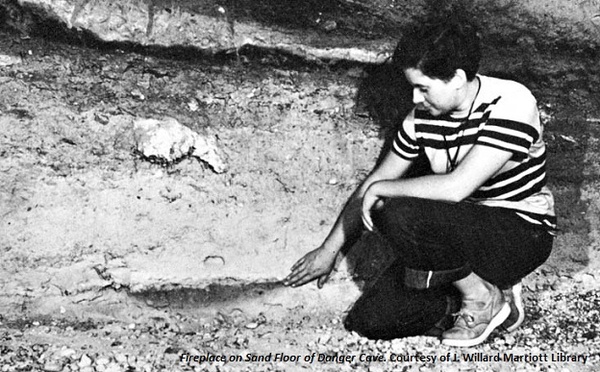Dublin Core
Title
Description
A seemingly non-descript cave in Utah’s west desert holds the key to understanding Utah’s ancient past.
To the untrained eye, Danger Cave near Wendover, Utah, is utterly unremarkable. But ask any archaeologist about this dusty desert cave and you’ll soon learn that it is one of the most famous and significant archaeological sites in all of North America.
The human history of Danger Cave dates back 11,000 years to a time when people hunted now-extinct animals like the mammoth. The cave is a rare time capsule of valuable scientific information about the people who persisted over thousands of years in the Great Basin desert.
Danger Cave was first researched in a comprehensive way by University of Utah archaeologist Jesse Jennings, who conducted major excavations there from 1949 to 1953. The dry cave was ideal for preserving intriguing artifacts like beetle wings and fossilized human feces. Jennings and his crew also found textiles and tools, animal bones, and remnants of 68 plant species that still grow in the area today. Taken together, this material tells us what people ate and how they took advantage of the many resources in their environment.
The truly exceptional thing about Danger Cave, however, is that it was the first site to provide a firm timeline of human occupation in the Great Basin spanning more than 10,000 years. The distinct layers of cultural material found in the cave were tested with radiocarbon dating, now a standard technology, but new at that time. The testing revealed dates older than most archaeological sites in North America. Even Jennings was surprised by these results.
Jennings’ interpretation of his findings at Danger Cave was also surprising. He broke new ground by proposing the presence of a unique Desert Archaic culture that had successfully adapted to the harsh conditions of an arid environment. His ideas provoked criticism at the time, but are now fundamental to our understanding of how humans have long lived in the arid deserts of the American West.
Creator
Source
Image: Fireplace on Sand Floor of Danger Cave. 1963. Located in Anthropology and the World of Science by Jesse D. Jennings. Courtesy of J. Willard Marriott Library.
_______________
See the fantastic I Love Archaeology website, created by the fine archaeologists of the Antiquities Section, Utah Division of State History, accessed at http://www.history.utah.gov/archaeology/i_love_archaeology/index.html; Jesse D. Jennings, Danger Cave, University of Utah Anthropological Papers, No. 27 (Salt Lake City: University of Utah Press, 1957); National Park Service, National Register of Historic Places Inventory – Nomination Form for Danger Cave, 1981, accessed at http://pdfhost.focus.nps.gov/docs/NHLS/Text/66000741.pdf; Paul Reeve, “Danger Cave Near Wendover Provided Clues to Ancient Utah Dwellers,” History Blazer, June 1995, http://historytogo.utah.gov; Tom Wharton, “Utah’s Little Known Danger Cave,” Salt Lake Tribune, May 1, 2011.

